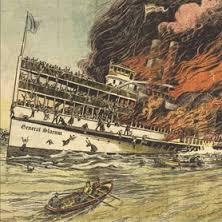8
Tourists to New York CIty invariably visit Little Italy in downtown Manhattan, even though very few people of Italian descent live there any more. But very few people – tourists or native New Yorkers – are aware that this section of the city used to be "Little Germany" – one of the largest and most vibrant ethnic enclaves in New York. But everything changed on June 15, 1904 after the deadliest tragedy in New York CIty's history until September 11, 2001.
It was, by all accounts, a glorious Wednesday morning on June 15, 1904, and the men of Kleindeutschland—Little Germany, on Manhattan’s Lower East Side–were on their way to work. Just after 9 o’clock, a group from St. Mark’s Evangelical Lutheran Church on 6th Street, mostly women and children, boarded the General Slocum for their annual end-of-school outing. Bounding aboard what was billed as the “largest and most splendid excursion steamer in New York,” the children, dressed in their Sunday school outfits, shouted and waved flags as the adults followed, carrying picnic baskets for what was to be a long day away.
Over 1,350 women and children from New York's German community boarded the ship that morning. Shortly after leaving the dock, the ship became a raging inferno:
Most of the passengers were women and children. As the ship made its way up the East River, good times turned bad very quickly. There have been varying accounts of how the fire started, but it spread rapidly within a half hour of leaving dock around 9 a.m. The panic was horrific among the passengers as they faced death by drowning or being burned alive on the ship. It was a safe bet that most of the passengers could not swim, and the period clothing of the day worked against them. '
This tragedy spelled the end of Kleindeutschland in New York City:
Although only one percent of Little Germany's population was killed by the disaster, those lost were members of the most established families, the social foundation of Little Germany's community, and the extent of the disaster had enormous repercussions on the St Mark's parish. The disaster as well as the accelerated exodus that was already well underway and the future anti-German sentiment that would occur during World War I would lead Kleindeutschland to extinction. Some bereaved parents, spouses, children, and friends committed suicide.[10] To further complicate matters, the desire to find a culprit, conflicting public opinion, and family quarrels among survivors about the distribution of money from a relief fund led the culture of Little Germany to turn sour.



0 comment
Funny that this tragedy has been totally forgotten.